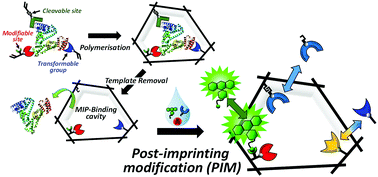当前位置:
X-MOL 学术
›
Chem. Commun.
›
论文详情
Our official English website, www.x-mol.net, welcomes your feedback! (Note: you will need to create a separate account there.)
Beyond natural antibodies – a new generation of synthetic antibodies created by post-imprinting modification of molecularly imprinted polymers
Chemical Communications ( IF 4.9 ) Pub Date : 2018-05-17 00:00:00 , DOI: 10.1039/c8cc02923g Toshifumi Takeuchi 1, 2, 3, 4, 5 , Hirobumi Sunayama 1, 2, 3, 4, 6
Chemical Communications ( IF 4.9 ) Pub Date : 2018-05-17 00:00:00 , DOI: 10.1039/c8cc02923g Toshifumi Takeuchi 1, 2, 3, 4, 5 , Hirobumi Sunayama 1, 2, 3, 4, 6
Affiliation

|
The molecular imprinting technology yields artificial materials capable of antibody-like molecular recognition. Molecularly imprinted materials are attractive because procedures for their preparation and use are comparatively simple. The number of research reports concerning molecularly imprinted polymers (MIPs) have been increasing yearly, attracting a great deal of interest in various fields. However, as most MIPs have been generated by relatively simple methods developed from the 1970s to the 2000s, resulting in MIPs bearing a single function, their capabilities are limited compared to those of multi-functionalised naturally occurring materials. Proteins are biosynthesised through multiple steps, including fabrication of peptide backbone and subsequent post-translational modifications that introduce additional functionalities, finally producing the mature protein. Post-imprinting modification (PIM) is an innovative strategy for generating MIPs analogous to biosynthetic proteins. New functionalities are introduced, in a site-directed manner, into a molecular imprinted cavity. Monomer residues in the cavity are chemically modified to incorporate new features, such as on/off switching of binding activity, fluorescence signalling, photoresponsivity, and finely tuned binding characteristics. In this Feature Article, we provide an overview of multifunctional MIPs prepared via PIMs developed earlier and the currently used state-of-the-art ones.
中文翻译:

超越天然抗体–通过分子印迹聚合物的印迹后修饰产生的新一代合成抗体
分子印迹技术产生了能够进行类抗体识别的人工材料。分子印迹材料具有吸引力,因为其制备和使用的程序相对简单。关于分子印迹聚合物(MIP)的研究报告的数量每年都在增加,引起了各个领域的极大兴趣。但是,由于大多数MIP是通过从1970年代到2000年代开发的相对简单的方法生成的,导致MIP具有单一功能,因此与多功能天然材料相比,它们的功能受到限制。蛋白质是通过多个步骤进行生物合成的,包括肽骨架的制造以及随后引入额外功能的翻译后修饰,最终产生成熟的蛋白质。印后修饰(PIM)是一种创新的策略,用于产生类似于生物合成蛋白的MIP。以定点方式将新功能引入分子印迹腔中。对空腔中的单体残基进行化学修饰,以结合新功能,例如结合活性的开/关切换,荧光信号传导,光响应性和微调的结合特性。在本专题文章中,我们概述了准备的多功能MIP 对空腔中的单体残基进行化学修饰,以结合新功能,例如结合活性的开/关切换,荧光信号传导,光响应性和微调的结合特性。在本专题文章中,我们概述了准备的多功能MIP 对空腔中的单体残基进行化学修饰,以结合新功能,例如结合活性的开/关切换,荧光信号传导,光响应性和微调的结合特性。在本专题文章中,我们概述了准备的多功能MIP通过较早开发的PIM和当前使用的最先进的PIM。
更新日期:2018-05-17
中文翻译:

超越天然抗体–通过分子印迹聚合物的印迹后修饰产生的新一代合成抗体
分子印迹技术产生了能够进行类抗体识别的人工材料。分子印迹材料具有吸引力,因为其制备和使用的程序相对简单。关于分子印迹聚合物(MIP)的研究报告的数量每年都在增加,引起了各个领域的极大兴趣。但是,由于大多数MIP是通过从1970年代到2000年代开发的相对简单的方法生成的,导致MIP具有单一功能,因此与多功能天然材料相比,它们的功能受到限制。蛋白质是通过多个步骤进行生物合成的,包括肽骨架的制造以及随后引入额外功能的翻译后修饰,最终产生成熟的蛋白质。印后修饰(PIM)是一种创新的策略,用于产生类似于生物合成蛋白的MIP。以定点方式将新功能引入分子印迹腔中。对空腔中的单体残基进行化学修饰,以结合新功能,例如结合活性的开/关切换,荧光信号传导,光响应性和微调的结合特性。在本专题文章中,我们概述了准备的多功能MIP 对空腔中的单体残基进行化学修饰,以结合新功能,例如结合活性的开/关切换,荧光信号传导,光响应性和微调的结合特性。在本专题文章中,我们概述了准备的多功能MIP 对空腔中的单体残基进行化学修饰,以结合新功能,例如结合活性的开/关切换,荧光信号传导,光响应性和微调的结合特性。在本专题文章中,我们概述了准备的多功能MIP通过较早开发的PIM和当前使用的最先进的PIM。



























 京公网安备 11010802027423号
京公网安备 11010802027423号